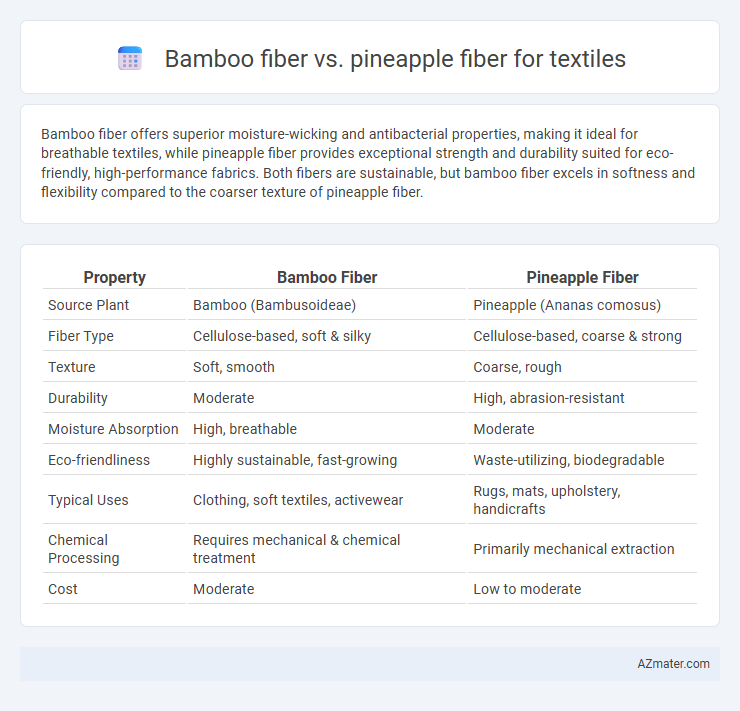Bamboo fiber offers superior moisture-wicking and antibacterial properties, making it ideal for breathable textiles, while pineapple fiber provides exceptional strength and durability suited for eco-friendly, high-performance fabrics. Both fibers are sustainable, but bamboo fiber excels in softness and flexibility compared to the coarser texture of pineapple fiber.
Table of Comparison
| Property | Bamboo Fiber | Pineapple Fiber |
|---|---|---|
| Source Plant | Bamboo (Bambusoideae) | Pineapple (Ananas comosus) |
| Fiber Type | Cellulose-based, soft & silky | Cellulose-based, coarse & strong |
| Texture | Soft, smooth | Coarse, rough |
| Durability | Moderate | High, abrasion-resistant |
| Moisture Absorption | High, breathable | Moderate |
| Eco-friendliness | Highly sustainable, fast-growing | Waste-utilizing, biodegradable |
| Typical Uses | Clothing, soft textiles, activewear | Rugs, mats, upholstery, handicrafts |
| Chemical Processing | Requires mechanical & chemical treatment | Primarily mechanical extraction |
| Cost | Moderate | Low to moderate |
Introduction to Natural Textile Fibers
Bamboo fiber and pineapple fiber both represent innovative developments in natural textile fibers, prized for their sustainability and eco-friendly properties. Bamboo fiber, derived from the pulp of bamboo grass, offers softness and antimicrobial benefits, making it ideal for clothing and home textiles. Pineapple fiber, extracted from pineapple leaves, provides a coarse yet durable texture used predominantly in traditional fabrics and composite materials recognized for their biodegradability and strength.
Overview of Bamboo Fiber
Bamboo fiber is a sustainable textile material derived from the pulp of bamboo grass, known for its softness, breathability, and natural antibacterial properties. It is highly favored in eco-friendly fashion due to its rapid renewability and biodegradability, offering moisture-wicking and UV protection benefits. Compared to pineapple fiber, bamboo fiber provides a smoother texture and higher comfort level, making it ideal for clothing and home textiles.
Overview of Pineapple Fiber
Pineapple fiber, derived from the leaves of the Ananas comosus plant, is valued for its high tensile strength, lightweight texture, and natural biodegradability, making it an eco-friendly alternative in textile production. This fiber is primarily used in fashion applications such as outerwear, upholstery, and luxury fabrics due to its durability and breathability. Compared to bamboo fiber, pineapple fiber offers a unique combination of softness and stiffness, providing sustainable options while reducing environmental impact.
Extraction and Processing Methods
Bamboo fiber extraction involves mechanical crushing and enzymatic retting to separate cellulose fibers, resulting in a soft, breathable textile ideal for eco-friendly fabrics. Pineapple fiber, known as Pina, is derived through hand-scraping the leaves followed by a series of washing and drying steps, producing a lightweight, lustrous fiber suited for traditional and luxury textiles. Both fibers emphasize sustainable processing, but bamboo relies more on enzymatic treatment while pineapple fiber extraction is predominantly manual and labor-intensive.
Environmental Impact: Bamboo vs Pineapple
Bamboo fiber is highly sustainable due to its rapid growth and minimal pesticide use, significantly reducing environmental impact compared to conventional fibers. Pineapple fiber, derived from pineapple leaves, utilizes agricultural waste, promoting waste reduction and circular economy benefits in textile production. Both fibers offer eco-friendly alternatives, but pineapple fiber's use of byproducts presents a lower overall ecological footprint by minimizing resource input and waste generation.
Physical Properties and Performance
Bamboo fiber offers excellent moisture-wicking, breathability, and antibacterial properties, making it highly suitable for activewear and comfort-focused textiles. Pineapple fiber, derived from leaves, exhibits superior tensile strength and durability, ideal for upholstery and high-performance fabric applications. Both fibers are biodegradable and sustainable, but bamboo provides softer texture while pineapple fiber delivers enhanced structural resilience.
Comfort and Wearability Comparison
Bamboo fiber offers superior moisture-wicking and breathability, making it ideal for comfortable, all-day wear in textiles. Pineapple fiber, also known as Pina, provides a lightweight, soft texture with natural antibacterial properties but tends to be less flexible and more prone to stiffness compared to bamboo. For wearability, bamboo fabric adapts well to various climates due to its temperature-regulating abilities, whereas pineapple fiber excels in luxury applications with a focus on aesthetics rather than stretch or durability.
Sustainability and Eco-friendly Aspects
Bamboo fiber is highly sustainable due to its rapid growth rate, requiring minimal water and pesticides, which significantly reduces environmental impact compared to conventional textiles. Pineapple fiber, derived from agricultural waste, promotes waste reduction and supports circular economy principles while offering biodegradability and low chemical use in processing. Both fibers contribute to eco-friendly textile production, with bamboo excelling in renewability and pineapple fiber championing resource efficiency and waste valorization.
Market Trends and Applications
Bamboo fiber and pineapple fiber are gaining momentum in the sustainable textile industry due to their eco-friendly properties and biodegradability, with bamboo fiber dominating the market because of its softness, antibacterial qualities, and moisture-wicking abilities. Pineapple fiber, derived from pineapple leaf waste, is increasingly used in luxury and artisanal textiles for its strength, durability, and natural sheen, appealing to niche markets focused on ethical fashion and eco-conscious consumers. Market trends indicate rising demand for both fibers in activewear, home textiles, and accessories, driven by growing consumer preference for sustainable and regenerative materials.
Future Prospects in Textile Industry
Bamboo fiber offers sustainable benefits such as rapid renewability, natural antibacterial properties, and biodegradability, making it a promising material for eco-friendly textile innovations. Pineapple fiber, derived from pineapple leaves, provides strong, lightweight, and breathable fabric ideal for premium and sustainable fashion markets, with growing interest in upcycling agricultural waste. Future prospects in the textile industry emphasize both fibers for enhancing circular economy practices and meeting increasing consumer demand for biodegradable, high-performance, and environmentally responsible materials.

Infographic: Bamboo fiber vs Pineapple fiber for Textile
 azmater.com
azmater.com